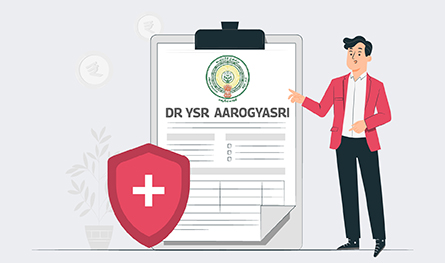GST on Insurance Premium and How Does GST Impact Insurance Premium
.png)
After the outbreak of the covid19 pandemic, adopting a healthy lifestyle has become very important. The fear of contracting the coronavirus has also increased due to poor hygiene, eating habits, and poor maintenance of upkeep of one’s self.
.png)
A recent report suggests that people are looking for cheap insurance policies to secure their health expenses because of the increasing growth of the covid19 pandemic. It is important to note here that along with the policy premium, GST or Goods and Service Tax is also applied, further increasing the cost of a health insurance policy, leading to an increase in insurance premium prices.
What is GST (Goods and Services Tax)?
The GST Bill could be India’s most significant tax reform since independence. The Govt of India passed it on 8 August 2016. GST is an indirect tax that has replaced all other indirect taxes in India. It is charged on the supply of goods or services and is multistage, destination-based taxation that calculates tax at each value addition point.
The GST council determines tax rates based on the four significant slab rates of 5%, 12%, 18%, and 28%. The GST rate for services is currently fixed at 18%.
GST on Insurance – GST Impact on Health Insurance, Term Life Insurance, and Other Insurance Premiums
In the past, service tax was levied on the insurance industry, at the rate of approximately 15% that included 14% basic service tax; 0.5% Swachh Bharath Cess; 0.5% Krishi Kalyan Cess. The system of service tax was abolished after the implementation of GST across the country.
The GST on insurance premiums has been increased to 18% from 1 July 2017 from the earlier 15 %. Due to this, the premiums of insurance policies rose by at least 3%. The premiums of all types of insurance policies were impacted due to this change. Now, let us take a detailed look at how GST impacted the premiums of these specific policies.
GST on Life Insurance Policy premiums
We now know that the goods and service tax is levied for providing services in the life insurance industry, and it can be calculated as below:
- GST on health insurance and life insurance policies that offer investment benefits is calculated on the premium deducted from the money allocated for investment. FOR EXAMPLE, in ULIP policies, GST is calculated on the premium minus any amount allocated to the investment.
- For single premium policies that include annuity options, it is 10% of the premium paid.
GST on Term Insurance
Since the premium paid by policyholders is wholly used for providing protection towards the policyholder’s life in the form of sum assured or coverage value, the GST is applied on the total premium.
GST on Endowment Plans
For the endowment plan, the GST calculation is taken on 25% of the first-year premium and 12.5% from the second and subsequent years. If an endowment plan’s premium is Rs. 1,00,000, the GST of 18% for the first year is calculated on a 25% premium (i.e., Rs. 25,000, and on Rs. 12,500 in subsequent years beginning from the second year.
GST on General Insurance Plans
With the case of general insurance plans like health insurance and motor insurance, marine insurance, and fire insurance, the GST is levied at the rate of 18% on the total premium. This is 3% more than the 15% service tax that was collected earlier.
Policy Exempt from GST
Not all insurance policies are taken into account for GST calculation. There are life insurance policies wherein the Indian government doesn’t levy any GST on the premium. They are PradhanMantri Jan Dhan Yojana, Jayashree Bima Yojanas (JBY), Aam Aadmi Bima Yojanas (AABY), etc., in order to provide benefits to the policyholder and to keep the cost of these policies affordable.
There is something called the input tax credits in GST, which is nothing but the amount of tax paid on output. One can get relief for the amount that was already paid. This is only available in very limited cases involving insurance. These credits are not available for life or health insurance premiums since they are not intended for personal use. Similarly, corporate policyholders’ life and health insurance policies do not qualify for any input credit. The only exception is the premium paid by group companies for general insurance policies.
Impact of GST on the Insurance Sector
With a 3% rise in the premiums for most insurance products, there is intense competition among the insurance companies in the market. In the insurance sector, being a highly price-sensitive market, companies try to lower their operating costs in order to maintain low premiums.
To retain customers and to showcase uniqueness, companies have improved their customer service to be the preferred insurance provider. For example, many insurers are offering flexible payment options, which include EMI’s that allow customers to choose between monthly, annual, or quarterly premium payments. Since the premium is often used to compare plans among insurers, customers might move to another provider if the premium charged by the competitor isn’t taken into account when launching new insurance policies.
The implementation of GST has undoubtedly increased the premium for most of the insurance policies. However, even if the premium is slightly higher due to GST on the insurance premiums, you should choose a plan that offers complete coverage and maximum benefits. With more than 20 insurance players in the country, you can review and assess the features of the policies available in the market and select the one which best suits your pocket and needs. In the event of a claim, the selection of insurance policies plays a significant role in helping you save thousands of rupees.
An insurance policy is designed to protect oneself and allow for a claim in the event of any mishap. Also, please pay attention to the amount of coverage that one underwrites as it is the prime parameter to tell how worthy a policy is for you and would it help you during an emergency situation. The claim settlement ratio of an insurance company is a crucial parameter to look at while making your choice. PayBima’s expert advice can help you get all the information related to GST and several other vital components that can impact your insurance premium.

Author Bio
Paybima Team
Paybima is an Indian insurance aggregator on a mission to make insurance simple for people. Paybima is the Digital arm of the already established and trusted Mahindra Insurance Brokers Ltd., a reputed name in the insurance broking industry with 21 years of experience. Paybima promises you the easy-to-access online platform to buy insurance policies, and also extend their unrelented assistance with all your policy related queries and services.
Latest Post
.png)
For ages, Indian women have been neglecting their health while giving priority to other things or the other people in their lives. In fact, health has always been given the least priority in most Indian women’s life in the past. Thus, very less number of Indian women have bought health insurance policies for themselves. And so, most of them especially the elderly struggle with illnesses without proper financial support to take care of their medical expenses.

.png)
The quality of air continues to deteriorate in India, especially in the northern region with the air quality index (AQI) in the critical category. This has increased the need for health insurance policies amidst rising concerns about the effects of air pollution on human health.

.png)
Health insurance provides financial support during medical and health emergencies. To continue availing the coverage benefits of a health insurance plan, it is required to pay a premium by the insured to the insurance company. But do you know what all factors are considered to determine the premium when buying a health policy? Let’s find out!


To allow health insurance benefits to economically weak people, every state government of India offers some schemes. One such scheme is the Dr. YSR Aarogyasri health scheme offered by the state government of Andhra Pradesh to help the poor and deprived section of the society, which was launched in the year 2007 by then Chief Minister Dr YSR Reddy.




